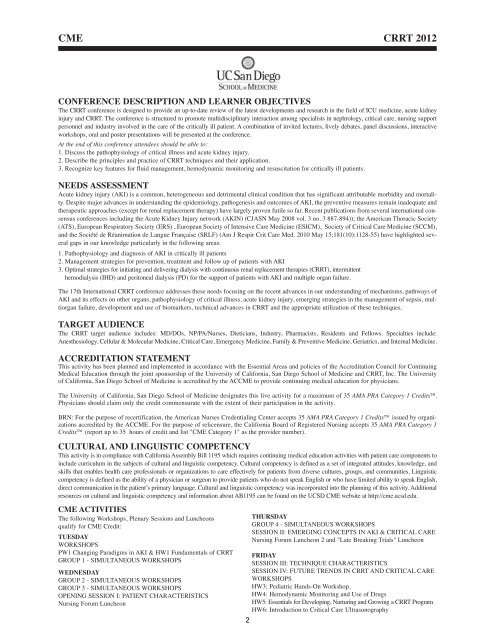ABSTRACTS from 16th International COnference on ... - CRRT Online
ABSTRACTS from 16th International COnference on ... - CRRT Online
ABSTRACTS from 16th International COnference on ... - CRRT Online
You also want an ePaper? Increase the reach of your titles
YUMPU automatically turns print PDFs into web optimized ePapers that Google loves.
CME <strong>CRRT</strong> 2012<br />
CONFERENCE DESCRIPTION AND LEARNER OBJECTIVES<br />
The <strong>CRRT</strong> c<strong>on</strong>ference is designed to provide an up-to-date review of the latest developments and research in the field of ICU medicine, acute kidney<br />
injury and <strong>CRRT</strong>. The c<strong>on</strong>ference is structured to promote multidisciplinary interacti<strong>on</strong> am<strong>on</strong>g specialists in nephrology, critical care, nursing support<br />
pers<strong>on</strong>nel and industry involved in the care of the critically ill patient. A combinati<strong>on</strong> of invited lectures, lively debates, panel discussi<strong>on</strong>s, interactive<br />
workshops, oral and poster presentati<strong>on</strong>s will be presented at the c<strong>on</strong>ference.<br />
At the end of this c<strong>on</strong>ference attendees should be able to:<br />
1. Discuss the pathophysiology of critical illness and acute kidney injury.<br />
2. Describe the principles and practice of <strong>CRRT</strong> techniques and their applicati<strong>on</strong>.<br />
3. Recognize key features for fluid management, hemodynamic m<strong>on</strong>itoring and resuscitati<strong>on</strong> for critically ill patients.<br />
NEEDS ASSESSMENT<br />
Acute kidney injury (AKI) is a comm<strong>on</strong>, heterogeneous and detrimental clinical c<strong>on</strong>diti<strong>on</strong> that has significant attributable morbidity and mortality.<br />
Despite major advances in understanding the epidemiology, pathogenesis and outcomes of AKI, the preventive measures remain inadequate and<br />
therapeutic approaches (except for renal replacement therapy) have largely proven futile so far. Recent publicati<strong>on</strong>s <str<strong>on</strong>g>from</str<strong>on</strong>g> several internati<strong>on</strong>al c<strong>on</strong>sensus<br />
c<strong>on</strong>ferences including the Acute Kidney Injury network (AKIN) (CJASN May 2008 vol. 3 no. 3 887-894)); the American Thoracic Society<br />
(ATS), European Respiratory Society (ERS) , European Society of Intensive Care Medicine (ESICM), Society of Critical Care Medicine (SCCM),<br />
and the Société de Réanimati<strong>on</strong> de Langue Française (SRLF) (Am J Respir Crit Care Med. 2010 May 15;181(10):1128-55) have highlighted several<br />
gaps in our knowledge particularly in the following areas:<br />
1. Pathophysiology and diagnosis of AKI in critically ill patients<br />
2. Management strategies for preventi<strong>on</strong>, treatment and follow up of patients with AKI<br />
3. Optimal strategies for initiating and delivering dialysis with c<strong>on</strong>tinuous renal replacement therapies (<strong>CRRT</strong>), intermittent<br />
hemodialysis (IHD) and perit<strong>on</strong>eal dialysis (PD) for the support of patients with AKI and multiple organ failure.<br />
The 17th <str<strong>on</strong>g>Internati<strong>on</strong>al</str<strong>on</strong>g> <strong>CRRT</strong> c<strong>on</strong>ference addresses these needs focusing <strong>on</strong> the recent advances in our understanding of mechanisms, pathways of<br />
AKI and its effects <strong>on</strong> other organs, pathophysiology of critical illness, acute kidney injury, emerging strategies in the management of sepsis, multiorgan<br />
failure, development and use of biomarkers, technical advances in <strong>CRRT</strong> and the appropriate utilizati<strong>on</strong> of these techniques.<br />
TARGET AUDIENCE<br />
The <strong>CRRT</strong> target audience includes: MD/DOs, NP/PA/Nurses, Dieticians, Industry, Pharmacists, Residents and Fellows. Specialties include:<br />
Anesthesiology, Cellular & Molecular Medicine, Critical Care, Emergency Medicine, Family & Preventive Medicine, Geriatrics, and Internal Medicine.<br />
ACCREDITATION STATEMENT<br />
This activity has been planned and implemented in accordance with the Essential Areas and policies of the Accreditati<strong>on</strong> Council for C<strong>on</strong>tinuing<br />
Medical Educati<strong>on</strong> through the joint sp<strong>on</strong>sorship of the University of California, San Diego School of Medicine and <strong>CRRT</strong>, Inc. The University<br />
of California, San Diego School of Medicine is accredited by the ACCME to provide c<strong>on</strong>tinuing medical educati<strong>on</strong> for physicians.<br />
The University of California, San Diego School of Medicine designates this live activity for a maximum of 35 AMA PRA Category 1 Credits.<br />
Physicians should claim <strong>on</strong>ly the credit commensurate with the extent of their participati<strong>on</strong> in the activity.<br />
BRN: For the purpose of recertificati<strong>on</strong>, the American Nurses Credentialing Center accepts 35 AMA PRA Category 1 Credits issued by organizati<strong>on</strong>s<br />
accredited by the ACCME. For the purpose of relicensure, the California Board of Registered Nursing accepts 35 AMA PRA Category 1<br />
Credits (report up to 35 hours of credit and list "CME Category 1" as the provider number).<br />
CULTURAL AND LINGUISTIC COMPETENCY<br />
This activity is in compliance with California Assembly Bill 1195 which requires c<strong>on</strong>tinuing medical educati<strong>on</strong> activities with patient care comp<strong>on</strong>ents to<br />
include curriculum in the subjects of cultural and linguistic competency. Cultural competency is defined as a set of integrated attitudes, knowledge, and<br />
skills that enables health care professi<strong>on</strong>als or organizati<strong>on</strong>s to care effectively for patients <str<strong>on</strong>g>from</str<strong>on</strong>g> diverse cultures, groups, and communities. Linguistic<br />
competency is defined as the ability of a physician or surge<strong>on</strong> to provide patients who do not speak English or who have limited ability to speak English,<br />
direct communicati<strong>on</strong> in the patient’s primary language. Cultural and linguistic competency was incorporated into the planning of this activity. Additi<strong>on</strong>al<br />
resources <strong>on</strong> cultural and linguistic competency and informati<strong>on</strong> about AB1195 can be found <strong>on</strong> the UCSD CME website at http://cme.ucsd.edu.<br />
CME ACTIVITIES<br />
The following Workshops, Plenary Sessi<strong>on</strong>s and Lunche<strong>on</strong>s<br />
qualify for CME Credit:<br />
TUESDAY<br />
WORKSHOPS<br />
PW1 Changing Paradigms in AKI & HW1 Fundamentals of <strong>CRRT</strong><br />
GROUP 1 - SIMULTANEOUS WORKSHOPS<br />
WEDNESDAY<br />
GROUP 2 - SIMULTANEOUS WORKSHOPS<br />
GROUP 3 - SIMULTANEOUS WORKSHOPS<br />
OPENING SESSION I: PATIENT CHARACTERISTICS<br />
Nursing Forum Lunche<strong>on</strong><br />
THURSDAY<br />
GROUP 4 - SIMULTANEOUS WORKSHOPS<br />
SESSION II: EMERGING CONCEPTS IN AKI & CRITICAL CARE<br />
Nursing Forum Lunche<strong>on</strong> 2 and "Late Breaking Trials" Lunche<strong>on</strong><br />
FRIDAY<br />
SESSION III: TECHNIQUE CHARACTERISTICS<br />
SESSION IV: FUTURE TRENDS IN <strong>CRRT</strong> AND CRITICAL CARE<br />
WORKSHOPS<br />
HW3: Pediatric Hands-On Workshop,<br />
HW4: Hemodynamic M<strong>on</strong>itoring and Use of Drugs<br />
HW5: Essentials for Developing, Nurturing and Growing a <strong>CRRT</strong> Program<br />
HW6: Introducti<strong>on</strong> to Critical Care Ultras<strong>on</strong>ography<br />
2
















